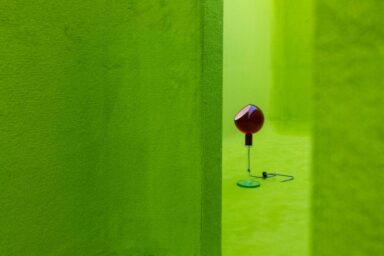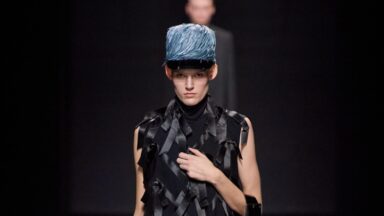On the second day of Milan Fashion Week, designers presented a series of collections that celebrated a lust for touch and life in many forms
Text by: Elisa Carassai
On the second day of Milan Fashion Week, designers presented a series of collections that celebrated a lust for touch and life in many forms.
Max Mara
Happy Birthday, Max Mara! For the celebration of the Italian fashion house’s 70th anniversary, Max Mara, established in 1951 by Achille Maramotti, transformed a room of Milan’s Triennale design museum into London’s Regent Street during festivities, with heraldic flags hanging from the ceiling. Might’ve creative director Ian Griffith been inspired by the Crown? It seems like he certainly drew some inspiration, as he mixed Britannic style with the Italian fashion house’s codes. Paying homage to some of Queen Elizabeth’s most iconic countryside looks, Griffith presented a collection that focused heavily on fantastically tailored outerwear: starting from an oversized selection of cabans to quilted overcoats, bomber jackets, and softly tailored cashmere parkas in Max Mara’s quintessential nude tones. Overall, Griffith’s Fall Winter 2021 collection was characterised by muted, natural tones, apart from a few stand out pops of mustard yellow. A must-see piece of the collection? A softly tailored, forest green velvet quilted coat, cinched at the waist by a skinny black belt and paired with hiking boots and a printed silk scarf strategically worn over the head. Indeed, something that would get the regal stamp of approval for a hunting trip at Balmoral.
Blumarine
Long live camp! It is evident Nicola Brognano is dreaming of a little lightness. In his second collection for the brand, the young designer presented a playful, glitzy ode to the early aughts in a celebration of the sexy aesthetic Paris Hilton and Britney Spears were mainly known for. Indeed, Brognano seems to be wanting to bring sexy back; as shown by the slinky silhouettes of pastel-coloured draped dresses, which left little to the imagination, and crystals are engraved on bras, belts and transparent bodies. Flowers and butterflies also seemed to be key leitmotifs of the collection, as roses were redrawn digitally or in abstract strokes and printed on low-waisted denim bell-bottoms; embroidered and applied in macramé on transparent tulle show-stopping dresses, or even on cropped BluVi’s and on large wool cardigans worked in plaits with fake-fur collars. Overall it was a fun collection that perfectly mixed the house codes with Brognano’s new vision for the brand.
Prada
Reflection and conversing on change and transformation are at the core of Prada. Case in point, for the third collection co-signed by Mrs Prada and Raf Simons, entitled Possible Feelings II: Transmute, the duo reflected on the role of clothing, understood not only as a free expression of the self and a reassuring instrument of protection but also as a means of breaking the typical fashion conventions. This analysis of canonical opposites – simplicity and complexity, elegance and practicality, limitation and freedom – aimed to be the first step towards an exploration of a new language, made of conceptual and material contradictions. The suit’s formality was unhinged with strategic cuts, and tailored coats were covered in sequins; tight-fitting jumpsuits became evening dresses. The body was covered in all its parts by turtleneck long johns in stretch jacquard knits, presented as a second skin to emphasise the idea of softness and comfort in relation to action and movement. Canadian musician and DJ Richie Hawtin returned to sign the fashion show’s soundtrack – the third one produced for Prada under the revered Plastikman pseudonym – creating a composition that intensifies the senses, invites movement, and evokes the dance floor as much as reflective inner worlds.
Moschino
Inspired by George Cukor’s 1939 film, The Women, Jungle Red, Moschino’s digital presentation opened with a stellar, all-female cast. And just as at the time Norma Shearer, Joan Crawford, Rosalind Russel had the task of interpreting the invented events of the New York bourgeoisie; today Dita Von Teese, Amber Valletta, Carolyn Murphy, Hailey Biber, Shalom Harlow (but not only) lent themselves to the task of transforming into reality creative director Jeremy Scott’s reinterpretation of the golden years of Hollywood. A show within the show that allowed them to play with the roles of the protagonists so as to give life to a mashup full of Moschino-isms in a nostalgic atmosphere illuminated by golden spotlights. The garments played with Moschino’s usual ironic vein: the proportions of pinstripe suits were exaggerated, prints reminiscent of the Little House on the Prairie covered dresses, and last but not least, diva-worthy dresses were embroidered with hearts and featured glamorous vintage maxi trains.
Emporio Armani
Aren’t all designers dreaming of the post-pandemic days where we’ll be able to eat out and enjoy life without masks? Once again, Giorgio Armani proved this, by looking back at a period of time that symbolized economic excess and glitz and glamour: the 80s. Ironically, the 80s were also the period of time where Armani rose to success, with his tailored suits made famous by Richard Gere’s cinematic performances. But while at the time, he aimed to dress women for the workplace, this time, Armani drew inspiration from the campy aesthetic that so many loved and hated at the same time. Filmed against a neon-lit backdrop, the designer presented a collection punctuated by macro-graphisms. The female silhouette is elongated and slim, with a high waist, while the male one is liquid and deconstructed, with wide jackets and low shoulders. Pinstriped suits are enriched by sequins, jacquard or raised knit, while a palette of punchy pinks and purples gives light to black and navy separates. Velvet and fur give the looks that daring edge the 80s were so well known for. Indeed, as demonstrated by his bold clothes, fearlessness seems to be Armani’s key to survival and success in this post-pandemic world.
GCDS
We’re only on day two of fashion week, but one thing’s for sure: designers miss clubbing and letting loose in their own way. At GCDS, Giuliano Calza presented GCDS Edibles: A Technicolour Symphony; a fashion film he wrote himself and produced in collaboration with creative agency CANADA, which is known for having directed multiple Tame Impala music videos. Starting off with a scene located in a deli where our protagonist takes a GCDS branded miracle pink pill, the film then explores the extent of our protagonists’ trip: a journey into multiple dimensions, from a green section to a sun coated land, a desert, a car crash site, a fiery fire land, a watery landscape and last but not least the moon. It comes as no surprise that the clothes presented in the video fuel a long-lost lust for days spent clubbing, touching, and kissing. The garments are also a continuation of Calza’s over-the-top street-inspired vision for the fashion house, where neon hues take over and are paired with glossy blacks, denim and the occasional pop of white. Calza plays a game of contrasts where tight-skimming short dresses are paired with thigh-skimming boots; tiny heart-shaped nipple-covers (you can’t really call those bralettes) are paired with high-waisted vinyl baggy pants; crystal-embellished dresses are worn over pretty much just black underwear. In the end, GCDS might not suit everyone’s taste but one thing’s certain: they are masters in marketing their collections.


